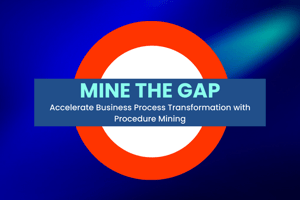BPO process mining process modeling
The Great Resignation: turning a business risk into a business asset
Knowledge is a company asset. I’m not talking about IP, patents, or secret formulas but rather the day-to-day knowledge of how things really work in your organization. The trouble with an asset like that is you rarely know how valuable it is until it’s gone.
Most companies share an unlikely characteristic with ancient cultures – oral tradition. It’s something that’s been around almost as long as humans have had speech. It exists on all four corners of the Earth and encompasses religious teachings, folktales, epic poems, and the storytelling traditions of indigenous cultures. It’s an excellent way of preserving both knowledge and experience and passing it from one generation to the next. What it’s not is the most effective way of documenting your business processes.
Knowledge locked up in individual heads can disappear whenever the owners of those heads walk out the door. It’s not a new problem, but the hasty lockdowns which resulted from the COVID-19 pandemic and the longer-lasting cultural and business repercussions have pulled it into the spotlight.
Welcome to the New Reality
In March 2020, most organizations abruptly shifted from an office-based workforce to one which was remote and dispersed. They adapted but assumed the crisis would be short-lived. Temporary workarounds abounded – band-aids whose primary design principle was the speed of deployment rather than efficiency or resilience. More than two years later, many of those band-aids are still in place because many employees liked not commuting to the office daily. Companies have become resigned to the fact that some form of remote work for most of their employees is here to stay.
While there are clear benefits to a remote workforce, such as lowered real estate costs, there are also downsides that must be addressed. Companies will have to change how people work, collaborate, and learn new roles. For example, how do new employees get trained if they can no longer just sit next to someone for a few weeks and learn on the job? Oral tradition works less well when the tribe is geographically scattered.
More concerning is the growing trend of opting out of the white-collar workforce altogether. The Great Resignation has highlighted and exacerbated the vulnerability many companies were already experiencing. Losing employee knowledge (down the drain if you will) has turned what was previously a trickle into a flood as employees with institutional experience leave in unprecedented numbers.
It’s a tough problem. Your newly remote workforce requires more efficient and effective processes to support it but, to develop them, you need to work from an accurate blueprint of how your company works. Job One is to eliminate the variance between what your process documentation says and what actually happens.
Turning a Risk into an Asset
In a previous blog, Process Mining: Stuck in the Mine, we discussed how BusinessOptix’s modeling capabilities allow you to capture process information not accessible to mining tools – such as knowledge held in people’s heads. You can either run conventional workshops or use rapid process capture (a way of crowdsourcing information using online surveys). The latter allows you to survey an entire department, giving depth and breadth of coverage – multiple answers about the same process capture all the exceptions and boundary conditions and smooth out any inconsistencies or contradictions you might get with smaller sample sizes. It’s a quick and effective way to discover how processes get executed in reality.
Once you have an accurate picture of how your business works, BusinessOptix enables you to produce the work instructions and support documentation that reflects the current state. These can be easily updated as you make changes to better deal with your new business reality. Having a single version of the truth, held centrally and accessible to all, means:
-
Employees can learn how processes work and execute them accurately.
-
Stakeholders can review and approve proposed changes.
-
Developers can use them to create user stories.
-
Change managers can use them to support their transformation programs and reduce the risk of unintended consequences.
-
Global and multi-national workforces are supported better because you can establish and document variations that meet local customer experience and compliance obligations and produce local language versions.
Institutional knowledge loss is like a leaking pipe – if you’re not careful, you’ll remain blissfully ignorant of it until the ceiling caves in. Don’t wait for knowledge loss to cripple your organization in this new workforce reality. BusinessOptix work instructions and documentation protects your organization by ensuring the accuracy of your processes and the smooth continuity of your operations. It also lays the foundations for transforming your company, making it more resilient and better able to weather the next inevitable crisis.



